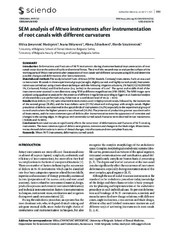Приказ основних података о документу
Sem analysis of Mtwo instruments after instrumentation of root canals with different curvatures
Analiza defekata MTwo instrumenata posle obrade kanala različite povijenosti (SEM)
| dc.creator | Jovanović-Medojević, Milica | |
| dc.creator | Milanović, Ivana | |
| dc.creator | Zdravković, Alena | |
| dc.creator | Stratimirović, Đorđe | |
| dc.date.accessioned | 2023-12-09T15:21:33Z | |
| dc.date.available | 2023-12-09T15:21:33Z | |
| dc.date.issued | 2021 | |
| dc.identifier.issn | 0039-1743 | |
| dc.identifier.uri | https://smile.stomf.bg.ac.rs/handle/123456789/3277 | |
| dc.description.abstract | Introduction. Deformations and fractures of Ni-Ti instruments during chemomechanical instrumentation of root canals occur due to the action of cyclic and torsional forces. The aim of this research was to analyze the surfaces of the working parts of Mtwo instruments after preparation of root canals with different curvatures using SEM and determine possible changes and deformations after instrumentation. Materials and methods. The study included 3 sets of Mtwo (VDW, Munich, Germany) instruments. Each set was used to instrument 10 canals in three experimental groups (straight, slightly curved, and highly curved canals). Instrumentation was carried out using crown-down technique with the following irrigation solutions, 2% NaOCl (CHLORAXID 2%, Cerkamed, Polska) and Distilled water (Iva, Serbia) in the amount of 5 cm3. The apical and middle third of the instruments were scanned in two directions using SEM at different magnifications (150-2000X). The SEM images were analyzed using qualitative analysis for the presence of different irregularities according to Eggert et al. Statistical analysis of obtained data was performed using Fisher test at a confidence level of 5% (α = 0.05). Results. Most defects (37.3%) were observed in instruments used in highly curved canals, followed by the instruments of the second group (35.6%), and the least defects were (27.1%) observed in the group with straight canals. Higher prevalence of defects was observed in the apical thirds of instruments (54.2%), especially in the experimental group of curved canals where the highest presence was observed (20.3%). The presence of production grooves was observed in all instruments, and the most common types of defects after instrumentation were the appearance of corrosion and changes in the cutting edges. In the group with extremely curved canals fractures were observed in two instruments (10/0.04 and 15/0.05). Conclusion. Root canal curvature significantly affects the occurrence of deformations and fractures of Ni-Ti rotating instruments. The most common types of defects were grooves, corrosion and changes in the blade edges. Mtwo instruments showed deformations in terms of thread changes, microfractures and two complete fractures. | sr |
| dc.description.abstract | Uvod Deformacije i fraktura Ni-Ti instrumenata tokom hemomehaničke obrade kanala nastaju usled dejstva cikličnih i torzionih sila. Cilj ovog istraživanja je bio da se primenom SEM-a analiziraju površine radnog dela MTwo instrumenata nakon preparacije kanala različite povijenosti i utvrdi eventualno postojanje promena i deformacija nakon instrumentacije. Materijali i metode U istraživanje su uključena tri seta MTwo (VDW, Munich, Germany) instrumenata. Svaki set je korišćen za obradu 10 kanala u tri eksperimentalne grupe (pravi, blago povijeni i izrazito povijeni kanali). Instrumentacija je realizovana kruničnoapeksnom tehnikom, a kao irigansi su primenjeni u količini od po 5 cm³, 2% rastvor NaOCl (CHLORAXID 2%, Cerkamed, Poljska) i destilovana voda (Iva, Srbija). SE snimci apikalne i srednje trećine instrumenata iz dva različita pravca, snimani pomoću SEM-a, na različitim uvećanjima (150-2000×) analizirani su kvalitativnom analizom prisustva različitih nepravilnosti po Edžeru i sar. Statistička analiza dobijenih podataka urađena je primenom Fišerovog testa na nivou pouzdanosti od 5% ( a = 0,05). Rezultati Najviše defekata (37,3%) uočeno je na instrumentima koji su upotrebljeni za obradu izrazito povijenih kanala, zatim na instrumentima druge grupe (35,6%), a najmanje defekata je bilo (27,1%) u grupi sa pravim kanalima. Veća zastupljenost defekata se uočava na apikalnoj trećini instrumenata (54,2%), posebno u trećoj eksperimentalnoj grupi, gde je uočeno najveće prisustvo - 20,3%. Uočeno je prisustvo proizvodnih žlebova na svim instrumentima, a najučestaliji tipovi defekta nakon instrumentacije su bili pojava korozije i promene sečivnih ivica. Uočene su frakture na dva instrumenta (10/0,04 i 15/0,05) u grupi sa izuzetno povijenim kanalima. Zaključak Na osnovu rezultata ove studije može se zaključiti da povijenost korenskog kanala znatno utiče na pojavu deformacija i prelom Ni-Ti rotirajućih instrumenata. Najučestaliji tipovi defekata su bili žlebovi, korozija i promene sečivnih ivica. MTwo instrumenti su pokazali deformacije u vidi promene navoja, mikrofraktura i dve kompletne frakture. | sr |
| dc.language.iso | sr | sr |
| dc.language.iso | en | sr |
| dc.publisher | Srpsko lekarsko društvo - Stomatološka sekcija, Beograd | sr |
| dc.rights | openAccess | sr |
| dc.rights.uri | https://creativecommons.org/licenses/by-sa/4.0/ | |
| dc.source | Stomatološki glasnik Srbije | sr |
| dc.subject | Mtwo | sr |
| dc.subject | Ni-Ti instruments | sr |
| dc.subject | deformation | sr |
| dc.subject | curved canals | sr |
| dc.subject | Ni-Ti instrumenti | sr |
| dc.subject | deformacije | sr |
| dc.subject | povijeni kanali | sr |
| dc.title | Sem analysis of Mtwo instruments after instrumentation of root canals with different curvatures | sr |
| dc.title | Analiza defekata MTwo instrumenata posle obrade kanala različite povijenosti (SEM) | sr |
| dc.type | article | sr |
| dc.rights.license | BY-SA | sr |
| dc.citation.volume | 68 | |
| dc.citation.issue | 3 | |
| dc.citation.spage | 131 | |
| dc.citation.epage | 142 | |
| dc.identifier.doi | 10.2298/SGS2103131J | |
| dc.identifier.fulltext | http://smile.stomf.bg.ac.rs/bitstream/id/8699/0039-17432103131J.pdf | |
| dc.type.version | publishedVersion | sr |


